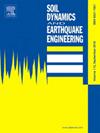Simulating multi-component near-fault ground motion record containing pulse-like component
IF 4.2
2区 工程技术
Q1 ENGINEERING, GEOLOGICAL
引用次数: 0
Abstract
Parametric models have been developed in the literature to simulate the near-fault seismic ground motion record component containing the pulse-like (PL) motion. However, the limited number of recorded records used to develop parametric models results in significant statistical uncertainty. An alternative method to simulate synthetic records with the PL component is the seed-record based approach. In this study, we propose the use of the iterative power and amplitude correction algorithm, along with three different transforms, to simulate the tri-component record containing the PL component. The approach requires a seed tri-component near-fault seismic ground motion record with the PL component. We compare the seed and simulated tri-component record in terms of the power distribution, coherence, velocity and displacement time histories, and response spectrum. The comparison is aimed at determining if the sampled record obtained using this approach can produce velocity and displacement time histories that are consistent with and have the same “natural variation and look" as the seed record. For the assessment, we treat a recorded record as a seed record. We also utilize a rotated version of the recorded record as the seed record, where one rotated record component in the horizontal plane is associated with the identified PL component. The numerical analysis results demonstrate a close match between the sampled records and the seed record in terms of velocity and displacement time histories, as well as the response spectrum and coherence characteristics.
模拟包含脉冲样成分的多成分近断层地动记录
文献中已经建立了参数模型来模拟包含脉冲样(PL)运动的近断层地震地动记录成分。然而,用于开发参数模型的记录数量有限,导致统计不确定性很大。基于种子记录的方法是模拟包含类脉冲运动的合成记录的另一种方法。在这项研究中,我们建议使用迭代功率和振幅校正算法以及三种不同的变换来模拟包含 PL 分量的三分量记录。该方法需要一个包含 PL 分量的种子三分量近断层地震地动记录。我们从功率分布、相干性、速度和位移时间历程以及反应谱等方面对种子记录和模拟的三分量记录进行比较。比较的目的是确定使用这种方法获得的采样记录是否能产生与种子记录一致并具有相同 "自然变化和外观 "的速度和位移时间历程。在评估中,我们将记录视为种子记录。我们还利用记录的旋转版本作为种子记录,其中水平面上的一个旋转记录分量与已识别的 PL 分量相关联。数值分析结果表明,采样记录和种子记录在速度和位移时间历程以及响应谱和相干性特征方面非常吻合。
本文章由计算机程序翻译,如有差异,请以英文原文为准。
求助全文
约1分钟内获得全文
求助全文
来源期刊

Soil Dynamics and Earthquake Engineering
工程技术-地球科学综合
CiteScore
7.50
自引率
15.00%
发文量
446
审稿时长
8 months
期刊介绍:
The journal aims to encourage and enhance the role of mechanics and other disciplines as they relate to earthquake engineering by providing opportunities for the publication of the work of applied mathematicians, engineers and other applied scientists involved in solving problems closely related to the field of earthquake engineering and geotechnical earthquake engineering.
Emphasis is placed on new concepts and techniques, but case histories will also be published if they enhance the presentation and understanding of new technical concepts.
 求助内容:
求助内容: 应助结果提醒方式:
应助结果提醒方式:


